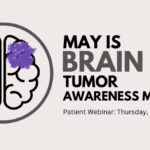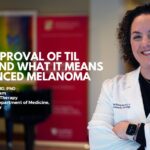

Melanoma en estadio III: alto riesgo de recidiva y (ahora) múltiples opciones
Las opciones de tratamiento adyuvanteen el estadio III fueron durante muchos años limitadas y duras, porque sólo había dos opciones. Desde 1995 hasta 2015, esas opciones eran la vigilancia o las dosis altas de interferón.
Estas opciones las suele dar un oncólogo al paciente después de que se le haya extirpado quirúrgicamente el tumor primario y haya habido una biopsia positiva de ganglio linfático centinela u otros hallazgos de metástasis regionales. Al paciente se le dijo que el melanoma en estadio III tiene un alto riesgo de recidiva.
La conversación fue difícil, sobre todo porque las opciones no ofrecían mucha seguridad de que el melanoma no volviera.
Las dos opciones estaban en los extremos opuestos del espectro. En un extremo estaba la vigilancia activa. La vigilancia significa que el equipo médico hace un seguimiento cuidadoso del paciente, probablemente realizando exámenes físicos y exploraciones de imagen varias veces al año para buscar signos de melanoma en el cuerpo del paciente. No se administra ninguna medicación y, por tanto, no se experimentan efectos secundarios.
En el otro extremo del espectro estaba el interferón, que era un tratamiento controvertido para el melanoma en estadio III, dada su conocida toxicidad y su dudosa eficacia.
Los efectos secundarios, a menudo brutales, incluían síntomas gripales, fatiga y síntomas neuropsiquiátricos. Y en 2005, los ensayos habían demostrado que "entre los pacientes destinados a recidivar, un año de tratamiento con dosis altas de interferón puede retrasar el momento de la recidiva en un pequeño subconjunto, aunque para la mitad de estos pacientes este retraso será inferior a 1 año. Sin embargo, la probabilidad global de recidiva y la supervivencia global no mejoran".1 En otras palabras, se sufría una toxicidad extrema a cambio de ningún beneficio para la supervivencia global y sólo una pequeña posibilidad de retrasar la recidiva -no de prevenirla- en aquellos que sí recidivarían.
Pero ahora la conversación es totalmente diferente
Existen potencialmente tres opciones para los pacientes en estadio III, y el interferón en dosis altas no es una de ellas. Los pacientes deben saber que ahora existen opciones que sí han demostrado su eficacia para prevenir la recidiva del melanoma.
Sin embargo, antes de que un oncólogo explique esas opciones a un paciente, es probable (y debería) que se analice el tumor del paciente para detectar un marcador llamado BRAF. Si esa prueba es positiva, como ocurre aproximadamente en el 50% de los casos, el paciente puede recibir una terapia dirigida.
La terapia dirigida actúa bloqueando determinadas proteínas para impedir que el melanoma crezca. El tratamiento consiste en una combinación de fármacos denominada Tafinlar y Mekinist. Se toman por vía oral. Sin embargo, hay que recordar que sólo son para los pacientes que dan positivo en la prueba BRAF.
La segunda opción es la inmunoterapia, que utiliza medicamentos diseñados para "despertar" el sistema inmunitario del cuerpo para luchar contra las células de melanoma extraviadas y puede ser tomada por todos los pacientes, independientemente del estado de BRAF. Dentro de la opción de la inmunoterapia hay varios fármacos diferentes que están actualmente aprobados para la terapia adyuvanteen fase III : Keytruda, Opdivo y Yervoy. Estos fármacos se administran generalmente por vía intravenosa.
Por último, la vigilancia activa sigue siendo una opción disponible para los pacientes en estadio III. Aquellos cuyo melanoma tiene un riesgo de recurrencia relativamente bajo (como un estadio IIIa) o aquellos que no pueden tolerar los efectos secundarios de los nuevos tratamientos son algunos de los que podrían seleccionar esta opción.
La conversación ha cambiado realmente para los oncólogos médicos y sus pacientes en estadio III debido a las nuevas opciones de tratamiento disponibles. La AIM recuerda a todos los pacientes del estadio III y a sus familias que las conversaciones son bidireccionales y que hay mucho que hablar con su oncólogo.
- Pregunte a su oncólogo si su tumor ha sido analizado para detectar la mutación BRAF.
- Pregunte si está en el estadio III A, B, C o D y hable de lo que eso significa.
- Pregunte qué opción le recomienda y por qué.
- Habla de las ventajas y desventajas de cada tratamiento.
Para prepararse para esas conversaciones, lea nuestro reciente artículo In Plain English, así como nuestra guía en línea titulada Opciones para el melanoma en estadio III: cómo tomar la decisión adecuada para usted (véase más abajo).
https://issuu.com/aimatmelanoma/docs/stage_iii_melanoma_diagnosis-15
Entradas recientes

Navigating the Journey Together – Conversations with Melanoma Caregivers

May is Brain Tumor Awareness Month

President’s Letter | April 2024

Celebrating a Milestone: 20 Years of the Dallas Steps Against Melanoma Walk

